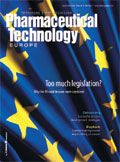Pharmaceuticals visualize success
Pharmaceutical Technology Europe
With a finger on the pulse of an evolving market, the sales and marketing team can visually demonstrate trends and new market opportunities to the R&D team
Pharmaceutical companies are under increasing pressure to find tomorrow's wonder drugs and dominate the major market segments. In the past year, they have also been under attack for poor research productivity, failures in drug safety and off-label marketing. The use of visual analysis could do much to improve their performance in research and across all areas of activity.
Better R&D analysis
A series of academic and consultancy studies have demonstrated that it takes about 15 years and costs $1 billion to bring a new drug onto the market. In the process, a mass of data is generated that presents a challenge, but also an opportunity. Hidden within that data there could be information that could cut short the development of poor candidates so that resources can be re-allocated for the development of more promising ones.
Unfortunately, conventional data analysis is too rigid. The methods are often discipline-specific so that information cannot flow freely between such disparate groups as chemists, biologists, clinicians and statisticians. Too often, pharmaceutical companies rely on static reporting tools that reveal historical trends, but restrict forward thinking.
To help companies respond more effectively to their data, analysis should be:
- Visual — so that results can be seen and understood by all parties.
- Interactive — so that researchers ask the questions that lead to breakthroughs.
- Guided — so that all users can benefit from the expertise of their colleagues.
Pharmaceutical companies are, therefore, turning to interactive visual analysis, in which data can be displayed in an array of linked, interactive plots that dramatically increase insight and understanding of complex data. With this technology, important data trends jump off the screen so that problems, opportunities and factors that contributed to the final results can be identified quickly.
The best analytical tools allow any researcher to extract and merge up-to-date data from technical and corporate sources with a few clicks. They have the ability to guide less familiar users through the process of conducting analysis. With such "guided analytics", users can formulate various "what if" scenarios and so make faster progress.
Improving drug safety
Visual analytics can also be applied for the earlier detection of potential safety problems, such as uncovering an association between an adverse event and a particular demographic subset of patients. The ability to browse and filter the data rapidly permits users to find answers to questions that may never have been asked in the past.
Beyond R&D
A great advantage of flexible visual analytics is that they can be applied across the range of business processes. R&D may be the heart and soul of a pharmaceutical company, but its analytics can also be effectively applied to other business units, such as sales and marketing.
In sales and marketing units there is a need to understand and respond to changing circumstances, such as external market influences and competitive forces. With visual business analytics, these parts of the organization can rapidly collate critical data without the intervention of an expert in information technology. Furthermore, with a finger on the pulse of an evolving market, the sales and marketing team can visually demonstrate trends and new market opportunities to the R&D team.
Sales teams can also use visual analytics to their advantage. In a highly competitive market, sales representatives need to be directed to the leading health care professionals in each particular therapeutic area. Just as R&D personnel can use visual analysis to make better use of research data, so their sales and marketing colleagues can use it to understand physician segmentation and targeting, sales force profiling and product line performance. Analytical applications easily fit into the sales and marketing process as well as incorporating the company's proprietary analysis tools, such as algorithms, and so give marketing analysts a powerful information advantage from existing data.
Visualizing competitive advantage
Applying analytics in R&D is not a novel concept. However, the ability to use the same techniques across the range of an organization's activities presents a new opportunity for pharmaceutical companies to gain not only an information advantage, but also a competitive advantage. Ease-of-use and interactivity allow pharmaceutical companies to model an array of theoretical scenarios so that drugs can be brought onto the market faster, with improved safety. By broadening visual analytics beyond the R&D process, companies can gain valuable insight in other business units and so improve performance on all fronts.
Christopher Ahlberg is the CEO of Spotfire Inc.

Drug Solutions Podcast: A Closer Look at mRNA in Oncology and Vaccines
April 30th 2024In this episode fo the Drug Solutions Podcast, etherna’s vice-president of Technology and Innovation, Stefaan De Koker, discusses the merits and challenges of using mRNA as the foundation for therapeutics in oncology as well as for vaccines.
PacBio Chosen as Tech Partner for Global Alzheimer’s Disease Research Project
April 23rd 2025The project, the North African Dementia Registry, will unite multiple entities for the purpose of developing a comprehensive dataset to advance the research community’s understanding of Alzheimer’s disease and other dementias in diverse populations.